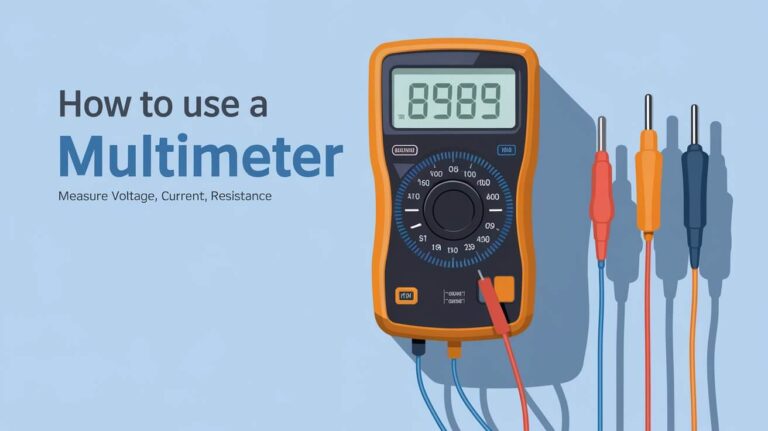How to Check a Fuse with a Multimeter: Step-by-Step Guide

Fuses are an essential part of electrical systems, protecting circuits from overcurrent by breaking the connection when the current becomes too high. Sometimes, diagnosing electrical issues comes down to determining whether a fuse is still functioning or has blown. This is where a multimeter comes in handy. In this guide, we’ll go step by step through how to check a fuse with a multimeter, ensuring you can troubleshoot electrical issues with confidence.
What is a Fuse?
Fuses play a crucial role in electrical systems by acting as a safety device that stops excess current from damaging electrical components. They are built to break or “blow” when current levels exceed the safe threshold for a circuit, cutting off power to prevent potential fire or device damage.
Purpose of Fuses in Electrical Systems
The primary function of a fuse is to protect electrical circuits. Fuses are installed in various devices, from household appliances to vehicles and industrial machines. By cutting off power in the event of an overcurrent, a fuse prevents overheating, fire hazards, and damage to connected devices.
Types of Fuses
- Cartridge Fuses: Cylindrical and found in homes and industrial equipment.
- Blade Fuses: Commonly used in automotive electrical systems.
- Glass Fuses: Transparent, allowing for easier visual inspection of breaks.
- Ceramic Fuses: More durable, usually found in high-current applications.
Common Signs of a Blown Fuse
Before diving into how to test a fuse with a multimeter, it’s helpful to recognize some of the common signs of a blown fuse:
- The device or system connected to the circuit doesn’t work.
- Darkened or discolored glass in glass fuses.
- Visible break in the fuse element (although not all breaks are visible).
- Burn marks on or near the fuse holder.
While a blown fuse may exhibit these signs, it’s important to use a multimeter to confirm the fuse’s condition, as visual inspection alone can be misleading.
Introduction to Multimeters
A multimeter is an indispensable tool for diagnosing electrical problems. It can measure several electrical properties, including voltage, current, and resistance. This makes it perfect for testing whether a fuse is working correctly or needs replacement.
What is a Multimeter?
A multimeter combines several measurement functions into one tool. Whether you’re working on an electrical system at home or on a vehicle, it can:
- Measure voltage: Detect how much electrical energy is flowing through a circuit.
- Measure resistance: Check how much opposition the circuit is giving to the flow of current.
- Measure continuity: Determine whether the circuit is complete or broken.
Basic Features of a Multimeter
- Probes: Red and black leads used to connect the multimeter to the circuit or component being tested.
- Dial: This selects the mode of measurement (voltage, current, resistance, continuity).
- Display: Where the results are shown, either as numerical values (for digital models) or needle movement (for analog models).
A multimeter’s versatility makes it a must-have tool for testing fuses and troubleshooting a wide range of electrical issues.
Why Use a Multimeter to Check Fuses?
Testing a fuse with a multimeter offers greater accuracy than visual inspection. Fuses can appear intact even when they are blown internally. By measuring resistance or continuity with a multimeter, you can definitively determine whether the fuse is still good or needs to be replaced.
Advantages of Testing Fuses with a Multimeter
- Accuracy: Multimeters provide definitive readings, detecting issues that may not be visible.
- Efficiency: Testing a fuse with a multimeter takes just a few moments and helps you avoid replacing unnecessary parts.
- Safety: Using a multimeter allows you to test fuses without touching them directly, which minimizes the risk of electric shock.
Safety Considerations Before Testing a Fuse
Before testing any fuse, it’s crucial to follow proper safety precautions:
- Turn off the power: Always ensure the circuit or device is powered down before removing or testing a fuse.
- Use insulated gloves: This helps prevent accidental shocks when working with electrical components.
- Handle the multimeter correctly: Ensure the probes are securely attached and that the multimeter is set to the correct mode to avoid inaccurate readings.
Tools Needed to Test a Fuse
Before you begin, gather the necessary tools for the job:
- Multimeter: Either digital or analog, depending on your preference.
- Replacement Fuses: If the fuse is blown, you’ll need to replace it with one of the same type and amperage.
- Fuse Puller: Especially useful for removing automotive fuses, as it allows for easier and safer extraction from the fuse box.
Step-by-Step Guide: How to Check a Fuse with a Multimeter
Step 1: Turn Off the Power
Before doing anything else, make sure the power to the circuit or device is turned off. Disconnect any electrical devices from their power source to avoid dangerous shocks.
Step 2: Remove the Fuse
Next, remove the fuse from its holder. Depending on the fuse type and location, this might involve using a fuse puller or unscrewing the fuse holder cover.
For automotive fuses, refer to your car’s manual to locate the correct fuse box and pull out the fuse using the appropriate tool.
Step 3: Set the Multimeter to the Correct Mode
Before testing, you need to set the multimeter to the correct mode:
- Continuity Mode: Ideal for a quick check, as the multimeter will beep if the fuse is good.
- Resistance Mode (Ohms): If using this setting, select a low range (typically 200Ω) to check for continuity within the fuse.
Step 4: Test the Fuse
Now, it’s time to test the fuse:
- Glass or Cartridge Fuse: Place one multimeter probe on each metal end of the fuse.
- Blade Fuse: Touch each probe to one of the fuse’s metal prongs.
The multimeter will measure the resistance or check for continuity.
Step 5: Interpret the Results
Once you’ve connected the probes, read the multimeter display:
- Zero or near-zero resistance: The fuse is functioning properly.
- Infinite resistance (“OL”): This indicates the fuse has blown and will need replacement.
- Beeping sound (in continuity mode): This confirms that the fuse is still intact and functioning.
Step 6: Replacing a Blown Fuse
If your multimeter shows infinite resistance or no continuity, the fuse is blown. Replace it with a new fuse of the same amperage rating. Installing a fuse with the wrong amperage can damage your circuit or cause future electrical issues.
Additional Considerations When Testing Fuses
Testing Car Fuses
Automotive fuses are typically blade fuses, which are easily tested with a multimeter. First, locate the car’s fuse box (refer to the manual if needed), and use a fuse puller to extract the correct fuse. Place the multimeter’s probes on the blades to test it. For most cars, the fuse box will have a diagram that indicates which fuses are associated with specific components.
Testing Fuses Without Removing Them
In some cases, you may be able to test a fuse without removing it from the circuit. Many fuse boxes allow access to the metal prongs while the fuse remains in place. This can save time, especially in automotive or industrial settings.
Common Issues When Testing Fuses
Sometimes, testing a fuse can give unclear results due to:
- Dirty Contacts: If the fuse contacts are dirty, clean them before testing for accurate readings.
- Faulty Multimeter: Check your multimeter on a known working circuit to ensure it is functioning correctly.
- Incorrect Multimeter Settings: Double-check that the multimeter is in the proper mode before testing the fuse.
FAQs on Testing Fuses with a Multimeter
How Do I Know If My Multimeter is Working Correctly?
To verify your multimeter is working correctly, test it using a known working fuse or short the probes together. In continuity mode, the multimeter should beep when the probes are connected.
Can a Fuse Be Blown Even If It Looks Fine?
Yes, a fuse can be internally damaged even if it appears fine externally. This is why using a multimeter is essential for accurate diagnostics.
Can You Test a Fuse with Power On?
It’s not recommended to test a fuse while the circuit is live. Always turn off the power supply before testing to avoid electric shock or damage to the multimeter.
Conclusion
Testing a fuse with a multimeter is an essential skill for anyone working with electrical systems. Whether you’re troubleshooting household appliances, automotive circuits, or industrial machines, knowing how to safely and accurately check a fuse can save time and prevent costly damage. By following the steps outlined in this guide, you can confidently use a multimeter to test and replace fuses, keeping your electrical systems running smoothly.




